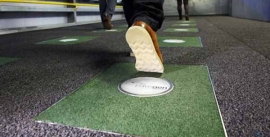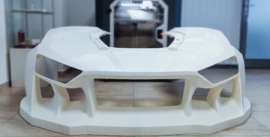 جدید
جدیدآلیاژ تیتانیوم – طلا، چهار برابر سخت تر از بیشتر فولادها
آلیاژ تیتانیوم – طلا
آلیاژ تیتانیوم – طلا
چهار برابر سخت تر از بیشتر فولادها
تیتانیوم ماده ای پیشرو برای اتصالات مفصل زانو و ران است زیرا این فلز، مستحکم، مقاوم به سایش و غیرسمی است اما یک اکتشاف غیرمنتظره توسط فیزیکدان های دانشگاه Rice نشان می دهد که اتصالات مصنوعی را با افزودن طلا به نسبت 3 به 1 و با ساختار اتمی خاصی می توان بهبود داد.
تیتانیوم ماده ای پیشرو برای اتصلات مفصل زانو و ران است زیرا این فلز، مستحکم، مقاوم به سایش و غیرسمی است اما یک اکتشاف غیرمنتظره توسط فیزیکدان های دانشگاه Rice نشان می دهد که اتصالات مصنوعی را با افزودن طلا به نسبت 3 به 1 و با ساختار اتمی خاصی می توان بهبود داد.
پروفسور امیلیا موروسن (Emilia Morosan)، سرپرست این پژوهش جدید می گوید:” این آلیاژ، 3 تا 4 برابر سخت تر از بیشتر فولادهاست و 4 برابر سخت تر از تیتانیوم خالص است که در حال حاضر در بیشتر ایمپلنت های دندانی و اتصالات جایگزین استفاده می شود.”
در واقع، ساختار اتمی این ماده با اتم هایی که در یک ساختار بلوری مکعبی- که مشخصه غالب آن سختی است، با فشردگی چیدمان شده اند قبلا شناخته شده بود. حتی مشخص نیست که پروفسور موروسن و دانشجوی همکار طرح، اتری اسوانیدزه (Eteri Svanidze)، نخستین کسانی باشند که نمونه ای خالص از شکل فراسخت بتای این ترکیب ساخته اند. اما از خوش اقبالی، آنها و همکارانشان نخستین کسانی هستند که خواص قابل توجه این ماده را مستندسازی می کنند.
پروفسور موروسن توضیح می دهد:” یکی از کارهایی که ما هنگام ساخت یک ترکیب جدید انجام می دهیم، تلاش برای خردکردن آن ترکیب به شکل پودر برای انجام آنالیز پرتوی ایکس است. این امر به شناسایی ترکیب شیمیایی، خلوص، ساختار بلوری و سایر خواص ساختاری کمک می کند. هنگامی که ما برای خرد کردن آلیاژ تیتانیوم-طلا تلاش کردیم نتوانستیم چنین کنیم. حتی من یک هاون و دسته الماسی (پوشش دهی شده) خردیم اما باز هم نتوانستیم آن را بطور کامل خرد کنیم.”
پروفسور موروسن و اسوانیدزه تصمیم به پیگیری آزمون هایی برای تعیین دقیق میزان سختی ترکیب گرفتند و نیز تصمیم گرفتند که سختی سایر ترکیبات تیتانیوم و طلا را که در مطالعه اولیه برای مقایسه استفاده کرده بودند اندازه گیری کنند.
یکی از ترکیبات دیگر ( آلیاژ تیتانیوم – طلا )، مخلوطی از سه قسمت تیتانیوم و یک قسمت طلا بود که در دمای بالا آماده سازی شده بود.
چیزی که گروه در آن زمان نمی دانستند این بود که ساختن آلیاژ تیتانیوم – طلا (تیتانیوم3- طلا) در دمای نسبتا بالا، یک فرم بلوری تقریبا خالص از نسخه بتای این آلیاژ تولید می کند. در دماهای کمتر، اتم ها به آرایش در ساختار مکعبی دیگری – فرم آلفای تیتانیوم3-طلا-تمایل داشتند. ساختار آلفا تقریبا به سختی تیتانیوم عادی است. به نظر می رسد که آزمایشگاه هایی که سختی تیتانیوم3-طلا را قبلا اندازه گیری کرده بودند، نمونه هایی را سنجش کرده بودند که بشدت از چیدمان آلفای اتم ها تشکیل شده بودند.
کاربردهای فیزیولوژیکی تیتانیوم؛ آچارفرانسه مهندسی پزشکی!
به جرئت می توان گفت در عصر حاضر، تیتانیوم اولویت اصلی برای تجهیزات ارتوپدی و دند...برای نمونه، برای ایمپلنت های زیست پزشکی، دو معیار کلیدی عبارتند از زیست سازگاری و مقاومت به سایش. چون تیتانیوم و طلا در آلیاژ تیتانیوم – طلا در میان زیست سازگارترین فلزات هستند و غالبا در ایمپلنت های پزشکی بکار می روند، گروه بر این باور بود که تیتانیوم3-طلا نیز همین طور خواهد بود. آزمایش ها توسط همکاران در دانشگاه تکزاس، مرکز سرطان شناسی اندرسون در هوستون مشخص نمود که این آلیاژ جدید، حتی زیست سازگارتر و دارای مقاومت به سایش بیشتری نسبت به تیتانیوم خالص می باشد.
پروفسور موروسن می گوید که گروه او، قصد انجام آزمایش های بیشتر برای بررسی بیشتر ساختار بلوری آلیاژ تیتانیوم – طلا (beta titanium-3-gold ) و بررسی این موضوع که آیا آلاینده های (دوپانت های) شیمیایی می توانند سختی آلیاژ را بیشتر کنند یا خیر دارند.
[divider]
Titanium-gold alloy four times harder than most steels
Titanium is the leading material for artificial knee and hip joints because it’s strong, wear-resistant and nontoxic, but an unexpected discovery by Rice University physicists shows that artificial joints can be improved with the addition of gold at a ratio of three to one and with a specific atomic structure.
“It is about three to four times harder than most steels,” said Professor Emilia Morosan, the lead scientist on a new study. “It’s four times harder than pure titanium, which is what’s currently being used in most dental implants and replacement joints.
“This compound is not difficult to make, and it’s not a new material,” she added.
In fact, the atomic structure of the material, with its atoms tightly packed in a ‘cubic’ crystalline structure that’s often associated with hardness, was previously known. It’s not even clear that Prof Morosan and former graduate student Eteri Svanidze, the study’s lead co-author, were the first to make a pure sample of the ultrahard ‘beta’ form of the compound. But due to a couple of lucky breaks, they and their co-authors are the first to document the material’s remarkable properties.
“One of the things that we do when we make a new compound is try to grind it into powder for X-ray purposes. This helps with identifying the composition, the purity, the crystal structure and other structural properties,” Prof Morosan explained. “When we tried to grind up titanium-gold, we couldn’t. I even bought a diamond (coated) mortar and pestle, and we still couldn’t grind it up.”
Prof Morosan and Svanidze decided to do follow-up tests to determine exactly how hard the compound was, and while they were at it, they also decided to measure the hardness of the other compositions of titanium and gold that they had used as comparisons in the original study.
One of the extra compounds was a mixture of three parts titanium and one part gold that had been prepared at high temperature.
What the team didn’t know at the time was that making titanium-3-gold at relatively high temperature produces an almost pure crystalline form of the beta version of the alloy. At lower temperatures, the atoms tend to arrange in another cubic structure – the alpha form of titanium-3-gold. The alpha structure is about as hard as regular titanium. It appears that labs that had previously measured the hardness of titanium-3-gold had measured samples that largely consisted of the alpha arrangement of atoms.
For biomedical implants, for example, two key measures are biocompatibility and wear resistance. Because titanium and gold by themselves are among the most biocompatible metals and are often used in medical implants, the team believed titanium-3-gold would be comparable. Tests by colleagues at the University of Texas MD Anderson Cancer Centre in Houston determined that the new alloy was even more biocompatible and wear-resistant than pure titanium.
Prof Morosan said her group is planning to conduct follow-up tests to further investigate the crystal structure of beta titanium-3-gold and to see if chemical dopants might improve its hardness further.











دیدگاه کاربران